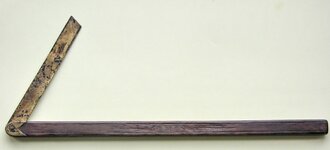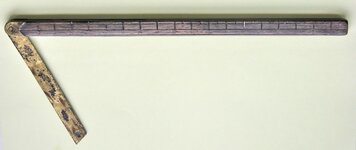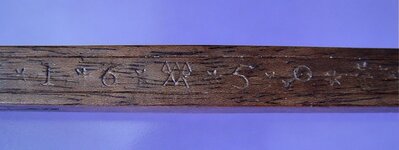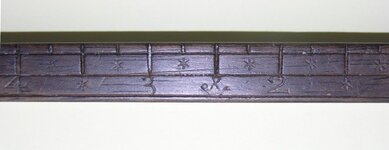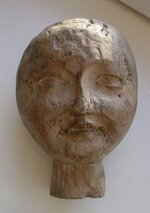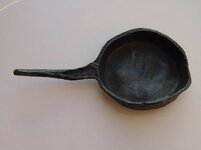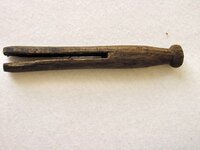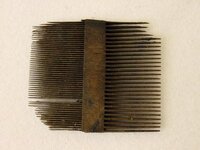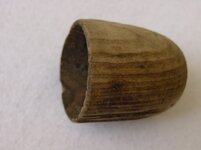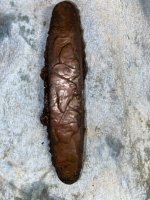woody50
Bronze Member
- Jun 21, 2007
- 1,879
- 203
- Detector(s) used
- XP Deus
- Primary Interest:
- All Treasure Hunting
Received some more data from the GMVV (Gewichten en Maten Verzamelaars Vereniging = Weights and measures collectors society) in Holland.
It's called a Zwaaihaak in dutch (english = Swing Hook, but thats just a google translation).
The length is good, must be 27.7cm and is divided into 10 thumbs (a thumb is about an inch).
That is a special official measure from Hoorn, The Netherlands. By the points 2.5 and 7.5 thumbs
a special symbol is given to show that that point is 1/4 foot and 3/4 foot.
It was called the (Citys) foot from Hoorn.
Dutch:
Je had deze zwaaihaak (ook: zweihaak) al eens aan mij laten zien, toen ik
samen met Gary Batz bij je op bezoek was, jaren geleden. De (stads) voet
van Hoorn meet 10 duim en is 27,7 cm lang. Daarom staan er vermoedelijk
bij 2,5 en 7,5 duim aparte tekens, om aan te geven dat het om 1/4 en 3/4 voet gaat.
In 1820 the metric system was introduced into Holland. Before that had some towns/cities and Providences in Holland their own measuring systems. Hoorn, where I live, was one of those towns, because it was on of the United East India Company's (the VOC) main towns where all its ships were repaired and revitalized. The Hoornse foot was 27.7 cm long, and that was divided into 10 parts.
A number of years ago, while searching in a deep pit where the VOC wharf was located I came across a piece of wood with my metal detector, because on the wood were mounted some brass parts. When I cleaned it off I found in my hand a measuring stick, made from wood and in perfect condition. Washing it off I saw the divisions of the stick, and when I turned it over to my surprise I saw a date, 1650! I almost jumped out of the deep pit in one movement, but just really climbed up the ladder. Looking more carefully in the daylight I also saw a makers mark (cure mark) on the stick. Wonder over wonder when I got home and really looked it was in PERFECT condition. Being under water since that date and in sticky clay mud had preserved the stick, just waiting to be found all that time.
Here in Holland its called a duimstok, translated that would be a thumb stick, that is because the 10 parts (2.7cm) are the widths of an average thumb.
I had the stick professionally preserved by a company here in Holland, it might not had to be done, but just to be sure. I don't know what sort of wood it is, could be palmwood. It has been one of my TOP finds for many years now, I often wonder which worker lost it and what he was doing on the ship when it fell into the water. Once in a lifetime find for sure, I have found other measuring sticks, but I imagine they were thrown away, because there is always a defect on them, and this is the only dated one I have ever seen.
It's called a Zwaaihaak in dutch (english = Swing Hook, but thats just a google translation).
The length is good, must be 27.7cm and is divided into 10 thumbs (a thumb is about an inch).
That is a special official measure from Hoorn, The Netherlands. By the points 2.5 and 7.5 thumbs
a special symbol is given to show that that point is 1/4 foot and 3/4 foot.
It was called the (Citys) foot from Hoorn.
Dutch:
Je had deze zwaaihaak (ook: zweihaak) al eens aan mij laten zien, toen ik
samen met Gary Batz bij je op bezoek was, jaren geleden. De (stads) voet
van Hoorn meet 10 duim en is 27,7 cm lang. Daarom staan er vermoedelijk
bij 2,5 en 7,5 duim aparte tekens, om aan te geven dat het om 1/4 en 3/4 voet gaat.
In 1820 the metric system was introduced into Holland. Before that had some towns/cities and Providences in Holland their own measuring systems. Hoorn, where I live, was one of those towns, because it was on of the United East India Company's (the VOC) main towns where all its ships were repaired and revitalized. The Hoornse foot was 27.7 cm long, and that was divided into 10 parts.
A number of years ago, while searching in a deep pit where the VOC wharf was located I came across a piece of wood with my metal detector, because on the wood were mounted some brass parts. When I cleaned it off I found in my hand a measuring stick, made from wood and in perfect condition. Washing it off I saw the divisions of the stick, and when I turned it over to my surprise I saw a date, 1650! I almost jumped out of the deep pit in one movement, but just really climbed up the ladder. Looking more carefully in the daylight I also saw a makers mark (cure mark) on the stick. Wonder over wonder when I got home and really looked it was in PERFECT condition. Being under water since that date and in sticky clay mud had preserved the stick, just waiting to be found all that time.
Here in Holland its called a duimstok, translated that would be a thumb stick, that is because the 10 parts (2.7cm) are the widths of an average thumb.
I had the stick professionally preserved by a company here in Holland, it might not had to be done, but just to be sure. I don't know what sort of wood it is, could be palmwood. It has been one of my TOP finds for many years now, I often wonder which worker lost it and what he was doing on the ship when it fell into the water. Once in a lifetime find for sure, I have found other measuring sticks, but I imagine they were thrown away, because there is always a defect on them, and this is the only dated one I have ever seen.
Attachments
Upvote
0


